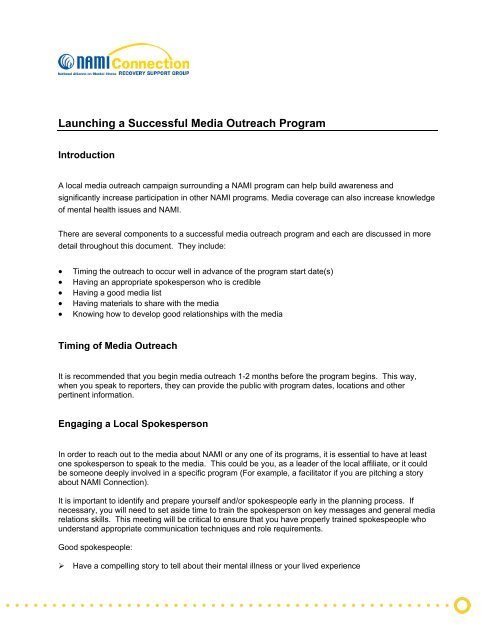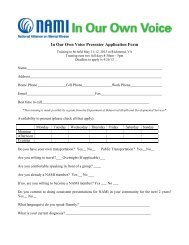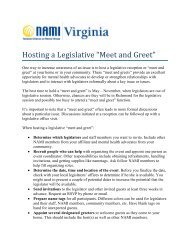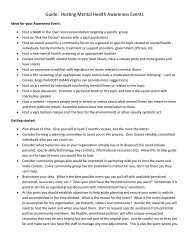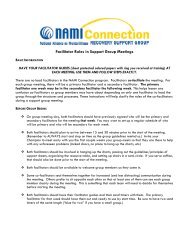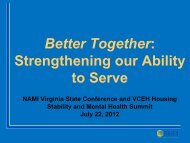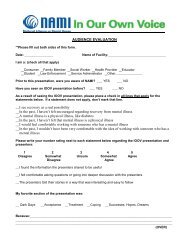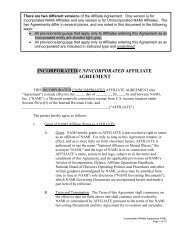Launching a Successful Media Outreach Program
Outreach Tips - NAMI Virginia
Outreach Tips - NAMI Virginia
- No tags were found...
You also want an ePaper? Increase the reach of your titles
YUMPU automatically turns print PDFs into web optimized ePapers that Google loves.
<strong>Launching</strong> a <strong>Successful</strong> <strong>Media</strong> <strong>Outreach</strong> <strong>Program</strong><br />
Introduction<br />
A local media outreach campaign surrounding a NAMI program can help build awareness and<br />
significantly increase participation in other NAMI programs. <strong>Media</strong> coverage can also increase knowledge<br />
of mental health issues and NAMI.<br />
There are several components to a successful media outreach program and each are discussed in more<br />
detail throughout this document. They include:<br />
• Timing the outreach to occur well in advance of the program start date(s)<br />
• Having an appropriate spokesperson who is credible<br />
• Having a good media list<br />
• Having materials to share with the media<br />
• Knowing how to develop good relationships with the media<br />
Timing of <strong>Media</strong> <strong>Outreach</strong><br />
It is recommended that you begin media outreach 1-2 months before the program begins. This way,<br />
when you speak to reporters, they can provide the public with program dates, locations and other<br />
pertinent information.<br />
Engaging a Local Spokesperson<br />
In order to reach out to the media about NAMI or any one of its programs, it is essential to have at least<br />
one spokesperson to speak to the media. This could be you, as a leader of the local affiliate, or it could<br />
be someone deeply involved in a specific program (For example, a facilitator if you are pitching a story<br />
about NAMI Connection).<br />
It is important to identify and prepare yourself and/or spokespeople early in the planning process. If<br />
necessary, you will need to set aside time to train the spokesperson on key messages and general media<br />
relations skills. This meeting will be critical to ensure that you have properly trained spokespeople who<br />
understand appropriate communication techniques and role requirements.<br />
Good spokespeople:<br />
‣ Have a compelling story to tell about their mental illness or your lived experience
‣ Are comfortable speaking to a reporter about their story and their mental illness or lived experience,<br />
understanding they will be publicizing the experience for public knowledge<br />
‣ Are friendly, focused and understand the key messages<br />
‣ Are generally available to speak to media<br />
NOTE: Although it is not recommended, if you cannot find spokespeople who will agree to disclose their<br />
name, you may choose to use someone who will agree to be interviewed anonymously. Please check<br />
with the reporter before setting up this type of interview as not all news outlets allow these types of stories<br />
to run. Another option is to only use a first name, or a pseudonym.<br />
You will probably want to start by looking at the people around you and with whom you work. Sometimes,<br />
a person who works for NAMI can be an appropriate spokesperson. As long as they have a compelling<br />
story to tell and are comfortable with media interviews, it can work. Additionally, consider people who<br />
have background knowledge about NAMI and direct experience with specific program you are promoting.<br />
‣ Local media outlets are generally interested in hearing personal stories.<br />
Once you have a spokesperson who has agreed to be interviewed, find out his/her story, as if you were a<br />
reporter. Write this down into a short biography that you can add to your press release and pitch letter to<br />
reporters.<br />
This part is very important because it is the human-interest portion of the story. An interesting story<br />
makes for a personal local news story that will interest reporters. Make sure the spokesperson is<br />
comfortable telling the story in a succinct and brief manner.<br />
Creating a <strong>Media</strong> List<br />
To ensure that your news about NAMI and its programs reach your target audiences, it is essential to<br />
identify the right media outlets and reporters. We recommend developing a comprehensive and diverse<br />
media list that includes local print, broadcast and radio outlets in your market.<br />
A media list is a document that contains details about local contacts and all the information you need to<br />
conduct business in your community.<br />
The Internet is a great resource for finding information to help you understand the media landscape in<br />
your county and develop the media lists, including detailed contact information for all media targets.<br />
To identify local media contacts:<br />
‣ Find your local media outlets (community TV stations, radio stations and newspapers) by searching<br />
the Internet, taking notice of newsstands or asking your local Chamber of Commerce. Select which<br />
ones you think may be interested in writing a news story about a NAMI program. You can monitor the
news coverage in your area for a week to see the types of stories they cover. You can even call the<br />
news desk at your local newspaper or television station and ask if they are interested in these types<br />
of stories.<br />
‣ Print publications, radio stations and television stations typically organize their employees by news<br />
specialty. There will probably be a specific person – either a reporter or editor – that focuses on a<br />
specific area of knowledge, or “beat.” News about NAMI and its programs would likely be of interest<br />
to editors/reporters on the following beats: Health, Features, Community, and Living.<br />
After you have your initial research, it’s time to compile a media list:<br />
‣ To develop a media list, obtain the contact information for each person you will be contacting at each<br />
media outlet. This may be as simple as calling the newspaper, TV station or radio station’s main<br />
number and asking the receptionist for the person’s name, phone extension, fax number and e-mail<br />
address. It may be helpful at this time to ask how a specific editor/reporter prefers to receive news<br />
(e.g., a phone call, e-mail, or fax).<br />
Capture all of the contact information in a media list. You can keep the media list in a format that is easy<br />
to organize and keep updated, such as in a Microsoft Word document or Microsoft Excel spreadsheet.<br />
A media list should include the following information:<br />
• Name of newspaper, radio station, television or Web site outlet<br />
• Contact name<br />
• Job title of contact<br />
• Mailing address (if appropriate)<br />
• E-mail address<br />
• Telephone number<br />
• Fax number (if appropriate)<br />
• Publication and contact notes<br />
• Section for notes to help you keep track of your outreach efforts and to keep track of<br />
information about the reporter that may be helpful in developing a long term relationship with<br />
him or her (i.e., areas of interest, how he/she likes to receive information, etc.)<br />
A good place to capture this information is by creating a table in Microsoft Word or in Microsoft Excel. If<br />
you need assistance in preparing a media list, please contact the NAMI media team by contacting<br />
Christine Armstrong (Christinea@nami.org) or call the NAMI office at 703-524-7600 and ask for the NAMI<br />
<strong>Media</strong> Relations department. A sample media list is included at the end of this document.
Developing Materials for Your <strong>Media</strong> <strong>Outreach</strong><br />
With this packet you will find materials that can help you conduct effective media outreach for a specific<br />
program. These include:<br />
‣ Background materials – History on the specific program (i.e., NAMI Connection), key messages to<br />
help prepare your spokesperson, and mock interview questions. Please read these materials before<br />
engaging a local spokesperson. Also, feel free to refine or change the key messages and<br />
backgrounder with additional information you have about your local affiliate<br />
‣ Fill-in-the-blank materials – Information and tools you can personalize to fit the needs of your<br />
community. You can access these word templates online at www.nami.org/connectionintranet.<br />
Developing a Good Relationship with the <strong>Media</strong><br />
Developing a solid relationship with your local media will help pave the way for future media coverage<br />
about NAMI and its programs, help garner positive press coverage for special events and promotions and<br />
build trust between you and local reporters. There are some simple things you can do right away to build<br />
good relationships with the media. These include:<br />
‣ Promptly returning a reporter’s call<br />
‣ Not calling a reporter when you know that he/she is on deadline<br />
‣ Keeping an updated media list<br />
‣ Positioning yourself as a trustworthy resource for the reporter<br />
‣ Understanding what is “newsworthy” to a particular reporter or media outlet<br />
Determining What is Newsworthy<br />
In order to effectively work with your local media outlets, you need to understand what they are looking<br />
for. Below is a list of the things that reporters and journalists are looking for:<br />
‣ Consequence. It’s essential that your story have news value and importance to the reading,<br />
listening and viewing public.<br />
‣ Interest. The information that you’re pitching to the journalist should have some unique, unusual or<br />
entertaining aspect to appeal to your audience’s interest.
‣ Timeliness. The material needs to be current or, if it’s an old story, it must have a new angle.<br />
Journalists are unlikely to write yesterday’s news. For example, a reporter will be interested in the<br />
start date of the classes and, if applicable, when people are able to start registering (if required).<br />
‣ Proximity. A local angle often attracts more interest because if the story truly affects the readers, it<br />
has a better chance of being reported.<br />
How to Pitch the <strong>Media</strong><br />
Sending an e-mail pitch<br />
First, we recommend e-mailing the appropriate contacts (or faxing, if they prefer) a ‘pitch letter.’ (A fill-inthe-blank<br />
pitch letter is provided in this kit.) The pitch letter announces the news and should include a<br />
personal story. This way, when you call the reporter, they have documents to refer to and are familiar<br />
with the story. We also recommend attaching the press release to this e-mail pitch. (For some programs,<br />
NAMI will provide you with a fill-in-the-blank press release.)<br />
Calling the <strong>Media</strong><br />
Sometimes it’s hard to pick up the phone and call a reporter with a story idea. But with the right knowhow,<br />
it can be a rewarding experience. Following are some helpful hints on how to work best with the<br />
media and successfully communicate your story angles and ideas.<br />
‣ Brainstorm creative news hooks<br />
Every day reporters receive dozens (if not hundreds) of e-mails, phone calls, letters and faxes from<br />
individuals pitching stories. There are, however, ways to communicate your news to make yours<br />
stand out. Consider what you can say and how you can say it. Some creativity behind your news<br />
might be the way to catch the attention of a reporter in your market.<br />
Also, read other local newspapers and magazines to see what news is popular or which specific<br />
trends are emerging in your area that you can relate to your story idea. This can help in making your<br />
story timely and more relevant to the reporter. For example, if there have recently been many stories<br />
written about mental health, you can mention this when you pitch the story. Or, if an outlet indicates<br />
that it is looking for stories about overcoming obstacles, you can pitch the story to that angle.<br />
‣ Do your homework<br />
Read recent stories by a reporter before you attempt your pitch. That way, when calling you can<br />
genuinely say you’ve been following what they cover and tie in your news with their recent stories.<br />
For example, if you’re e-mailing a reporter a story idea about NAMI Connection, you can bring up a<br />
recent story that the reporter wrote that ties into your pitch. An easy way to bridge to your story is to<br />
say, “Recently I read your story on mental illness in your newspaper and thought that you would be
interested in learning that at the National Alliance on Mental Illness, we run a program that may be<br />
relevant to your readers .…”<br />
‣ Follow up<br />
Once you’ve sent your pitch via fax or e-mail, follow-up with the reporter within 24 hours. It’s best to<br />
continue to follow up with reporters until you reach them for an actual live conversation since they are<br />
not typically fond of receiving numerous voice-mails. Only after trying to reach them live over a twoday<br />
period should you leave a voice-mail with your pitch and contact information.<br />
‣ Be helpful and accessible<br />
Members of the media are often on deadline and need information quickly to complete a story or<br />
segment. When working with the media, be available and prepared to take a journalist’s call for<br />
additional information or to confirm facts. If you’re not in the office, be sure to leave your contact<br />
information.<br />
If a reporter is interested in your story:<br />
• Find out what you can do to help the reporter by e-mailing additional information such as a<br />
fact sheet, biography of the spokesperson or details about the program<br />
• Ask if they would like to set up an interview with the spokesperson<br />
• Find out when the suggested spokesperson can speak to the reporter based on the reporter’s<br />
availability<br />
• Confirm the time with both parties and make sure everyone both has materials they<br />
requested<br />
If a reporter isn’t interested in your story:<br />
• Find out why -- it may be that the reporter is on deadline and doesn’t have time to listen to<br />
you at that moment<br />
• The reporter may be interested in story ideas from you, but just not that specific pitch – ask<br />
for the reporter’s e-mail address if you do not have it already in your media list<br />
Preparing for the Interview<br />
Once a reporter is interested in the story, you will need to contact your spokesperson, if appropriate, and<br />
coordinate a time that is acceptable to everyone. Or, you can ask if the reporter can call the<br />
spokesperson directly.<br />
If you have not already done so, please share the backgrounder, key messages and <strong>Media</strong> 101 guide<br />
with the spokesperson and/or review these yourself. You can cover key messages by holding a mock<br />
interview.
After the Interview<br />
After the interview occurs, stay in touch with the reporter to determine when the story will air or be in print.<br />
Provide the reporter with other interviews or information if necessary.<br />
In Summary<br />
You’ve just covered a lot of information on working with the media. In summary, think about the following<br />
as your keys to success:<br />
• Prepare a good media list that includes the needs and wants of reporters you wish to target<br />
• Prepare yourself and/or your spokesperson and arm him/her with key messages and background<br />
information about the program you are pitching<br />
• Develop a good case for pitching your story, one that shows it is relevant and timely to the audience<br />
you want to reach<br />
• Think of media relations as an ongoing process that requires building a trusting, respectful<br />
relationship with reporters
A SAMPLE MEDIA LIST<br />
This is one way you could set up a media list. The key here is to set it up in a way that is easy for you<br />
understand and easy to update.<br />
LOCAL NEWSPAPERS<br />
Publication Contact Title E-mail Phone # Notes<br />
Local Newspaper 1 Jane<br />
Jones<br />
Features<br />
Reporter<br />
jjones@localnewspaper1.com 555-555-<br />
1234<br />
Prefers to be contacted<br />
by e-mail.<br />
Local Newspaper 1 Amy<br />
Ayes<br />
Health Editor aayes@localnewspaper1.com 555-555-<br />
1233<br />
Send e-mail for inclusion<br />
in calendar of events.<br />
About Local Newspaper 1:<br />
Local Newspaper 1 is a general interest daily newspaper with a daily circulation of 100,000. Coverage area includes ABC<br />
county. The publication is broken into four sections: front page news, Metro, Sports and Entertainment. Every Thursday is the<br />
weekend guide that features upcoming community events and attractions.<br />
Local Newspaper 2 Bob<br />
Smith<br />
Editor bsmith@localnewspaper2.co<br />
m<br />
555-555-<br />
2345<br />
Prefers to be contacted<br />
Thursday/Friday mornings<br />
by phone with story idea.<br />
He will pass along<br />
information to appropriate<br />
reporter.<br />
About Local Newspaper 2:<br />
Local Newspaper 2 is a weekly newspaper for ABC town published every Wednesday. Features local community events, local<br />
government issues, and grade and high school news and sports.<br />
LOCAL TELEVISION STATIONS<br />
Publication Contact Title E-mail Phone # Notes<br />
Local Television<br />
Station 1<br />
Doug<br />
Peter<br />
Morning<br />
Show<br />
Producer<br />
dpeter@localtelevisionstation<br />
1.com<br />
555-555-<br />
3456<br />
ext 123<br />
Send information by e-<br />
mail first. Follow up with<br />
phone call between 10<br />
a.m. and 11 a.m. on<br />
Tuesdays or Wednesdays<br />
only.<br />
Local Television<br />
Station 1<br />
Cindy<br />
Start<br />
News<br />
Reporter<br />
cstart@localtelevisionstation1.<br />
com<br />
555-555-<br />
4567<br />
Send story ideas by e-<br />
mail only. She will follow<br />
up if she is interested.<br />
About Local Television Station 1:<br />
Local Television Station 1 is the NBC broadcast affiliate for ABC county. Shows include News this Morning, News at Noon,<br />
News at 5, News at 6 and Nightly News at 10.


